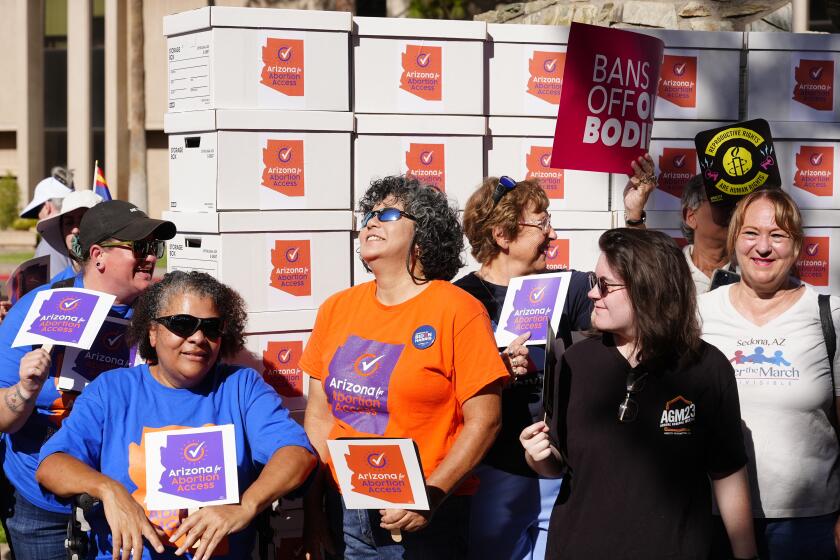Stanford Stand-Off : University-Owned Property Is Site of Farm Labor Dispute
In an unlikely setting for a farm labor dispute, Stanford University faces a deadline today over whether it will support unionization of 57 farmhands living and working in substandard conditions on university-owned property next to the sprawling campus.
The deadline was set Wednesday morning by the university’s own on-campus union, United Stanford Workers. The union has given Stanford officials until noon to decide if it will accept the union as the official representative of the farm workers.
USW, which is affiliated with the normally urban Service Employees International Union, organized the farm workers and wants to represent them in salary and working-condition talks with the university and Stanley Webb, the grower whose family has leased the bucolic farmland northwest of the school since 1922.
Stanford lawyer Michael Vartain said Thursday that it is “highly unlikely” that the university will be able to respond by the deadline. Stanley Webb’s son, Gary, declined to discuss the matter Thursday on the advice of his family’s lawyer.
Union representative Michael Tatham said that if a positive response is not made by the deadline, the workers will petition the state Agriculture Labor Relations Board in San Jose to hold a formal election on the matter among the workers.
United Stanford Workers Secretary Ramon Mayo said 53 of the 57 workers at the small vegetable and fruit ranch already had signed cards supporting the union as their official collective bargaining agent.
The issue could prove embarrassing for Stanford, which is one of the nation’s wealthiest universities and which just this week raised its annual tuition fee, with room and board, to $19,164.
Tivurcio Cabrerra makes $4.25 an hour laboring in the rich farmland owned by the university. The others are also paid that wage, even when doing contract work on campus--work for which the university reportedly pays Webb $8.50 an hour. Tatham said Webb pockets the difference.
Webb also deducts 75 cents an hour from all wages for rent, as well as additional fees for electricity and gas in the cinder-block and plywood shacks in which most of the workers live.
Cabrerra and his wife, Cointa Mendoza, said they have lived in their room for eight years. They said they like Webb personally, but no longer want to live in their current situation or work for their current wages.
“When we first came here, we tried to talk to them (ranch managers),” Cabrerra said, “but they say, ‘If you are not happy, try to look for another job.’ ”
Illegal Aliens
Most of the workers could not do that, he said, because they were in the country illegally and thought they had to suffer whatever conditions were presented to them. They all have since applied for legal residency under the new federal amnesty program, he added, and so they feel confident enough to bring in the union.
The flat rent fee applies regardless of the number of hours worked each week. According to one recent monthly pay stub released by the union, one worker paid $126.75 to sleep with up to six other people in an unheated 9-by-10-foot room. An additional $40 was subtracted for electricity and $60.53 for gas from the wages of $655.40.
After other deductions for Social Security, unemployment insurance and a personal loan, the unidentified worker netted $358.12 for a month of 48-hour work weeks--a little more than $2 an hour.
Electricity in half the camp is provided by extension cords from the other half. There is one communal bathroom for the entire camp, including three toilets lined up side by side with no stalls separating them. Men, women and children are expected to share the facilities, said one resident, Manuel Chavez.
“It’s a typical migrant labor situation,” said Jim Eggleston, the union’s lawyer in Oakland. “I think it’s fair to say the same conditions can be found all over the Central Valley. But it is especially stark when it happens there, in one of the richest areas in the country, and at Stanford, one of the richest universities in the country.”
Heart of Silicon Valley
Stanford is fondly referred to by staff and alumni as “The Farm,” a reference to its early days when it was surrounded by agricultural land. Now it sits in the heart of the so-called Silicon Valley, which it helped create, and the farm workers toil within sight of luxurious hilltop houses overlooking San Mateo County, one of the five wealthiest counties in the United States.
Vartain said Stanford is concerned about conditions at the labor camp, but said the university did not know if it violates any laws or if the school was aware of the conditions before the union made them public Wednesday.
“The university does not employ the Webb Ranch folks and never has,” he said. “The university is a very large institution and we have a lot of lessees and contractors . . . and we don’t have the resources to (monitor) labor conditions at all of them.”
Union officials disputed both ideas. Tatham said the school knew of the camp conditions for at least a year, ever since the union complained about the contracting of some campus maintenance services to Webb. He added that state law holds the landowner, not the lessee, responsible for labor camp conditions on agricultural lands.
More to Read
Sign up for Essential California
The most important California stories and recommendations in your inbox every morning.
You may occasionally receive promotional content from the Los Angeles Times.










